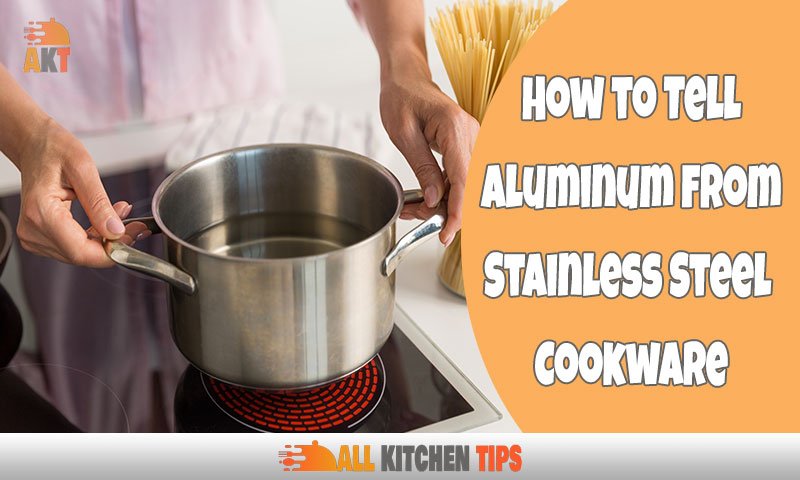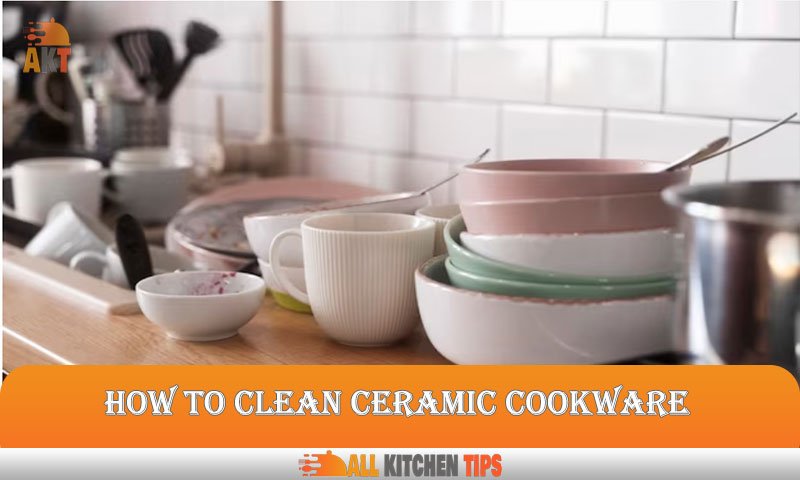To tell aluminum from stainless steel cookware, use a magnet. Aluminum is non-magnetic, while stainless steel is magnetic.
Cookware is an essential tool in every kitchen. However, with a range of materials available, it can be challenging to choose the right one. Aluminum and stainless steel are two popular materials used in cookware. Aluminum cookware is lightweight, while stainless steel is durable and corrosion-resistant.
However, it’s essential to know which one you’re using to avoid misusing the cookware. Some recipes require specific cookware, and using the wrong one can affect the taste and quality of your food. Recognizing the difference between aluminum and stainless steel cookware is critical to achieving the desired result. In this article, we’ll discuss how to tell aluminum from stainless steel cookware.
Understanding The Differences Between Aluminum And Stainless Steel Cookware

When it comes to purchasing cookware, two of the most popular materials are aluminum and stainless steel. While both are excellent choices, there are differences between them that might influence your decision. In this post, we will explore the advantages and disadvantages of each material, as well as the key differences between them.
What Is Aluminum Cookware, And What Are Its Advantages And Disadvantages?
Aluminum is a soft and lightweight metal that’s generally affordable and an excellent conductor of heat, making it a popular material for cookware. It is easy to form and can be used to create various shapes, which is why many manufacturers prefer it.
Benefits of Aluminum Cookware:
- Cooks food evenly and quickly due to its excellent heat conductivity
- Lightweight and easy to handle, especially for those with arthritis or weak wrists
- Budget-friendly, making it an excellent choice for beginners
- Can be used with acidic foods, such as tomatoes and vinegar, without leaching harmful chemicals
- Non-reactive and easy to clean
Drawbacks of Aluminum Cookware:
- Scratches and dents easily, which can cause it to warp over time
- Not ideal for induction cooktops
- Prone to discoloration and staining
- Not as durable as other materials, such as stainless steel
What Is Stainless Steel Cookware, And What Are Its Advantages And Disadvantages?
Stainless steel is a popular material for cookware due to its durability, resistance to scratches, and timeless appearance. It is a combination of metals, including iron, chromium, and nickel, making it resistant to rust and corrosion.
Benefits of Stainless Steel Cookware:
- Highly scratch-resistant, making it a durable option
- Retains its shine and luster even with regular use
- Can be used on all types of cooktops, including induction
- Non-reactive, allowing it to cook acidic foods such as tomato sauce and citrus without affecting the taste or harming the finish
- Dishwasher safe, easy to clean, and resistant to stains and odors
Drawbacks of Stainless Steel Cookware:
- Can be a poor conductor of heat, making it prone to hot spots and uneven cooking
- Expensive, making it less budget-friendly than other materials
- Heavy and difficult to handle, especially for those with weak wrists or arthritis
- Prone to sticking food
Key Differences Between The Two Types of Cookware:
While both aluminum and stainless steel cookware have their advantages and drawbacks, there are key differences between them.
- Heat conductivity: Aluminum conducts heat better than stainless steel, and therefore, heats up faster and cooks food evenly. Stainless steel, on the other hand, is less conductive, meaning it takes longer to heat up and can cause hot spots or uneven cooking.
- Durability: Stainless steel is more durable than aluminum, resisting scratches, dents, and warping over time.
- Reactivity: Aluminum is reactive with acidic foods, such as tomato sauce or citrus fruits. Stainless steel is non-reactive, preventing any reaction with the food and affecting the taste or finish of the cookware.
- Cost: Aluminum cookware is more budget-friendly than stainless steel, which is relatively expensive.
Both aluminum and stainless steel cookware have their advantages and disadvantages, and the right choice for you may depend on your needs, budget, and cooking style. By understanding the differences between the two, you can make an informed decision and find the cookware that best suits your needs.
Crucial Tips For Distinguishing Aluminum From Stainless Steel Cookware

When it comes to purchasing cookware, it’s essential to know the material of the product. Two common materials that are used for cookware are aluminum and stainless steel, but how do you differentiate between the two? Here, we will provide crucial tips for distinguishing aluminum from stainless steel cookware.
Examining The Physical Differences
Look and feel of the cookware:
- When examining cookware, aluminum typically has a more natural shine than stainless steel.
- Stainless steel has a slightly darker and duller appearance.
- Stainless steel has a smoother surface compared to aluminum, which has a slightly ridged texture.
Weight of the cookware:
- If you’re trying to differentiate between aluminum and stainless steel cookware, the weight of the product is a key factor.
- Aluminum cookware is relatively lightweight, whereas stainless steel cookware is denser and heavier.
The thickness of the cookware:
- Take a close look at the thickness of the product.
- Stainless steel cookware is generally thicker than aluminum cookware.
Testing The Cookware With A Magnet
Explanation of how a magnet is useful for distinguishing between aluminum and stainless steel cookware:
- One of the easiest ways to differentiate between aluminum and stainless steel cookware is by using a magnet.
- Since aluminum is not magnetic, the magnet will not stick to the aluminum surface.
- Stainless steel cookware, on the other hand, is magnetic, so the magnet will stick to the surface.
Conducting A Heat Conductivity Test
Why heat conductivity is an important factor:
Heat conductivity is an important factor to consider when purchasing cookware.
- Efficient heat conductivity helps to cook food efficiently and evenly.
Methods for testing heat conductivity:
- Heat a small amount of water in both the aluminum and stainless steel cookware on low heat for a few minutes.
- Place a thermometer into the water to measure the temperature of the water.
How to interpret the results of a heat conductivity test:
- Aluminum cookware heats up faster and distributes heat evenly throughout the pot or pan.
- Stainless steel cookware takes longer to heat up but retains heat efficiently once it has reached the desired temperature.
Understanding the physical differences, conducting a magnet test, and testing heat conductivity are the key methods for distinguishing between aluminum and stainless steel cookware. With these crucial tips, you can confidently purchase the cookware that’s right for you and enjoy cooking your favorite dishes without any hassle.
Caring For Your Cookware
Cookware is an essential part of every kitchen, and selecting the right kind can make a big difference in the quality of food you cook. It is important to know how to differentiate between aluminum and stainless steel cookware because they require different care.
Best Practices For Cleaning Aluminum Cookware
Aluminum cookware is a favorite among home cooks because it is lightweight, affordable, and conducts heat well. However, it needs proper care to last a long time. Here are some cleaning practices to keep in mind:
- Avoid abrasive cleaners that can scratch the surface of the cookware
- Use gentle detergents and a soft sponge or cloth to clean the cookware
- Do not use steel wool or other harsh scrubbers as they can damage the non-stick coating
- Rinse the cookware thoroughly with warm water after washing to remove any soap residue
- Dry the cookware immediately after washing to avoid water spots or discoloration.
Storing Aluminum Cookware
Storing aluminum cookware properly is just as important as cleaning it. Here are some tips to keep in mind:
- Store the cookware in a dry and cool place to avoid corrosion or discoloration
- Stack the cookware carefully to avoid scratches or dents
- Do not store the cookware with metal utensils that can cause scratches.
Best Practices For Cleaning Stainless Steel Cookware
Stainless steel cookware is durable, long-lasting, and can give your kitchen a modern look. To keep it in good condition, observe the following cleaning practices:
- Avoid harsh cleaners that can damage the stainless steel and remove the shine
- Use microfiber cloths or soft sponges to clean the cookware. Avoid using steel wool or other abrasive scrubbers, which can leave scratches
- To remove tough stains, soak the cookware in vinegar or baking soda solution before washing
- To restore the shine, use a stainless steel polish.
Polishing Stainless Steel Cookware
Polishing stainless steel cookware is essential to maintaining its luster. Here are some tips to keep in mind:
- Apply a small amount of polish to the cookware and spread it evenly with a microfiber cloth.
- Buff the cookware gently in circular motions, paying attention to areas with stains or discoloration.
- Rinse the cookware with warm water and dry it with a soft cloth.
Additional Tips For Extending The Life Of Your Cookware
Maintaining your cookware does not end with just cleaning and storing. Here are some additional tips to extend the life of your cookware:
- Use the appropriate cookware for the task at hand. Do not use metal utensils with non-stick cookware, for example.
- Avoid heating the cookware when it is empty, as it can cause warping or discoloration
- Use low to medium heat when cooking. Cooking at high heat can burn the food and damage the cookware
- Do not put extremely hot cookware in cold water, as the sudden temperature change can warp or crack the cookware.
By following these tips, you can keep your aluminum and stainless steel cookware in good condition for a long time. With proper care, your cookware can help produce delicious meals for years to come.
People Also Like: Discover the Best Tips for How to Care for Wooden Bowls
FAQs
How Can I Distinguish Between Aluminum And Stainless Steel Cookware?
One way to distinguish between aluminum and stainless steel cookware is by checking their weight.
Is Stainless Steel Cookware Better Than Aluminum Cookware?
Stainless steel cookware is generally more durable and long-lasting than aluminum cookware but it can be more expensive.
Can I Use Metal Utensils On Aluminum And Stainless Steel Cookware?
Metal utensils can be used on stainless steel cookware but not on aluminum cookware as it can scratch the surface.
Is It Safe To Cook Acidic Foods In Aluminum Or Stainless Steel Cookware?
It is safe to cook acidic foods in stainless steel cookware but not in aluminum cookware, as it can react with the acid.
Conclusion
Hopefully, this article has helped you in understanding the key differences between aluminum and stainless steel cookware. While both types have their advantages and disadvantages, it’s important to consider your needs and preferences before choosing the right one for you.
If you want something lightweight, easy to clean, and affordable, go for aluminum cookware. On the other hand, if you want something durable, long-lasting, and with excellent heat retention, then stainless steel cookware might be a better option. Regardless of your choice, make sure to care for your cookware properly to extend its lifespan.
Hopefully, armed with this knowledge, you can now make an informed decision when purchasing your next set of pots and pans. Happy cooking!





